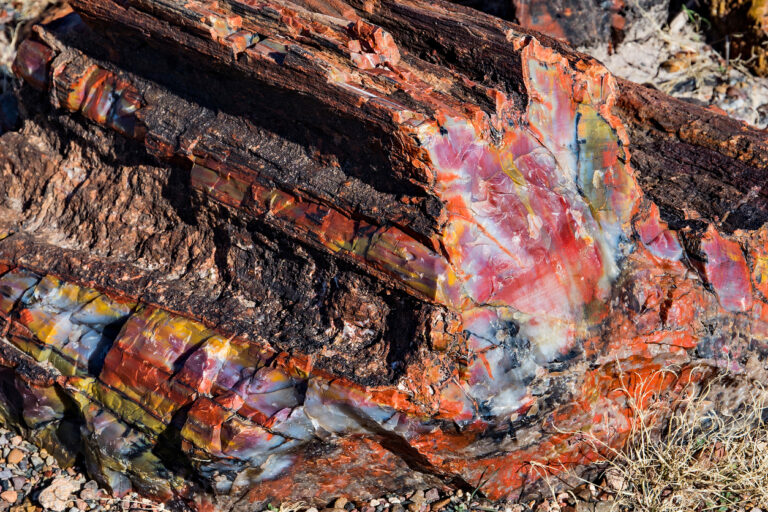Table of Contents
Petrified wood, a unique and intriguing gemstone, is formed through the fossilization of ancient trees, where organic material is replaced by minerals over millions of years. This process captures the intricate details of the wood’s original structure, creating a stone that symbolizes endurance, longevity, and transformation. It also connects with the Earth’s energy, grounding the wearer and providing stability and calm.
Formation
Petrified wood is formed through a process called permineralization. When a tree falls and is rapidly covered by sediment, it becomes protected from decay due to oxygen and organisms. Over time, mineral-laden water flows over the wood, and minerals like silica (quarts, chalcedony, jasper, opal and more) slowly replace the original wood tissues. This mineral replacement occurs on a microscopic level, maintaining the original structure and details of the wood. The process can take millions of years, resulting in a fossilized piece of wood where the organic material has been completely replaced with minerals.
Color
Petrified wood primarily exhibits earthy and neutral tones, including browns, creams, and grays, reflecting the original wood structure’s mineral replacement. It can also show other colors like red, green, yellow, and blue, depending on the specific minerals that permeated the wood during the petrification process.
Origins
Petrified wood is found in various locations around the world, with some of the largest and most significant deposits located in the United States, particularly in the Petrified Forest National Park in Arizona. This region is renowned for its extensive and beautifully preserved petrified wood. Other notable areas include Madagascar, known for its colorful petrified wood, and Egypt, where pieces of petrified wood have been discovered in the deserts. Additionally, countries like Argentina, Brazil, and Indonesia also have notable deposits, each contributing to the global diversity of petrified wood with unique characteristics influenced by their specific geological histories.
History
Petrified wood, formed over millions of years through the process of permineralization, holds a remarkable place in both geological and human history. Originating from a time when trees, buried under sediment, underwent a mineral replacement that preserved their structure in stone, petrified wood dates back to periods such as the Late Triassic, around 225 million years ago, with famous examples like Arizona’s Petrified Forest. Historically, it has been utilized in various cultures for construction, decorative arts, and was often associated with spiritual and healing properties, surrounded by folklore and mythology that marveled at its transformation from wood to stone. Indians used to carry it when they went on journeys and wars. Today, petrified wood is treasured both as a scientific specimen, offering insights into prehistoric ecosystems, and as an artistic material, polished for use in jewelry and decorative objects. Its unique beauty and connection to Earth’s ancient past make it a prized item among collectors, while many petrified forests are now protected areas, conserving these natural wonders for scientific study and public appreciation. Most of the petrified wood are between 66 million and 500 million years old.
Spiritual Aspects
- Connection to the Earth: strengthen one’s connection with the Earth, grounding the spirit and stabilizing one’s energies, impart stability.
- Past-Life Recall: some practitioners use it for meditation, especially for accessing past life memories or understanding karmic cycles.
- Wisdom: associated with the wisdom of the ages, it’s thought to provide guidance and understanding, particularly for making difficult decisions.
- Longevity and Perseverance: Symbolizes the eternal nature of the spirit, imparting lessons of patience and understanding the flow of life.
Emotional Aspects
- Calming: help soothe emotions, providing a sense of calm and comfort in times of stress, and assist us in thinking more clearly and making more effective decisions
- Courage: considered a symbol of courage due to its transformation over millions of years from wood to stone, representing resilience and adaptability. assist in overcoming fears, especially related to change or transformation.
- Transformation: often used as a tool to aid in coping with and embracing life’s transitions. It offers stability and grounding during times of change, a reflection of its own transformative journey, which symbolizes profound and gradual change.
- Mental Clarity: can increase clarity and focus, assist in decision-making, and offer insights into current challenges.
- PTSD: aid in releasing past traumas, including those believed to be stored at a cellular level or passed down through DNA.
Physical Aspects
- DNA and Cells: can help with DNA and cellular damage caused by environmental pollutants.
- Skeletal System: can aid in strengthening bones and improving skeletal system issues, reflecting its own sturdy nature.
- Detoxification: help in detoxifying the liver and cleansing the blood, though these claims are not scientifically substantiated.

